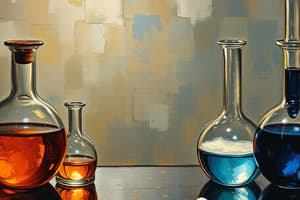Podcast
Questions and Answers
What property of solids allows them to keep their shape?
What property of solids allows them to keep their shape?
- Particles are spread far apart
- Particles vibrate in a fixed position (correct)
- Particles are free to move
- Particles are loosely packed
Gases are easy to compress due to their particles being closely packed.
Gases are easy to compress due to their particles being closely packed.
False (B)
What is the term for a solid that does not dissolve in a liquid?
What is the term for a solid that does not dissolve in a liquid?
insoluble
In the process of ________, a solid is separated from a liquid using filter paper.
In the process of ________, a solid is separated from a liquid using filter paper.
Which method would you use to separate a mixture of colors in ink?
Which method would you use to separate a mixture of colors in ink?
Match the separation technique with its description:
Match the separation technique with its description:
During a change of state, the temperature of a substance changes continuously.
During a change of state, the temperature of a substance changes continuously.
What is the purpose of the condenser in a distillation setup?
What is the purpose of the condenser in a distillation setup?
Flashcards
Particle Model
Particle Model
The idea that all matter is made up of tiny particles that are constantly moving.
Diffusion
Diffusion
The movement of particles from an area of high concentration to an area of low concentration.
Solute
Solute
A substance that dissolves in a liquid to form a solution.
Solvent
Solvent
Signup and view all the flashcards
Solution
Solution
Signup and view all the flashcards
Distillation
Distillation
Signup and view all the flashcards
Chromatography
Chromatography
Signup and view all the flashcards
Filtration
Filtration
Signup and view all the flashcards
Signup and view all the flashcards
Study Notes
States of Matter and Separation Techniques
-
Particle Model
- Solids: Particles vibrate in fixed positions, close together
- Liquids: Particles slide over each other, close together
- Gases: Particles are far apart, free to move in all directions
-
Changes of State
- Heating a substance gives it energy
- Particles gain energy to overcome forces between them
- Temperature remains constant during a change of state (flat line on graph)
-
Diffusion
- Particles in a liquid or gas spread from high to low concentration until equal
-
Dissolving
- Solvent: Liquid
- Solute: Solid
- Solution: Mixture of solid and liquid
- Soluble: Solid dissolves in liquid
- Insoluble: Solid does not dissolve in liquid
Separation Techniques
-
Distillation
- Separates substances with different boiling points
- Heat salt water, water boils at 100°C and evaporates
- Water vapor cools and condenses in a condenser back to liquid water
-
Filtration
- Separates insoluble solids from liquids
- Solid particles are too large to pass through filter paper
-
Chromatography
- Separates colours in a mixture
- Water rises up the paper and drags coloured inks
- More soluble ink travels further
- Rf value calculated to identify pure substances
- 𝑅𝑓 = Distance moved by the substance / Distance moved by the solvent
Studying That Suits You
Use AI to generate personalized quizzes and flashcards to suit your learning preferences.




